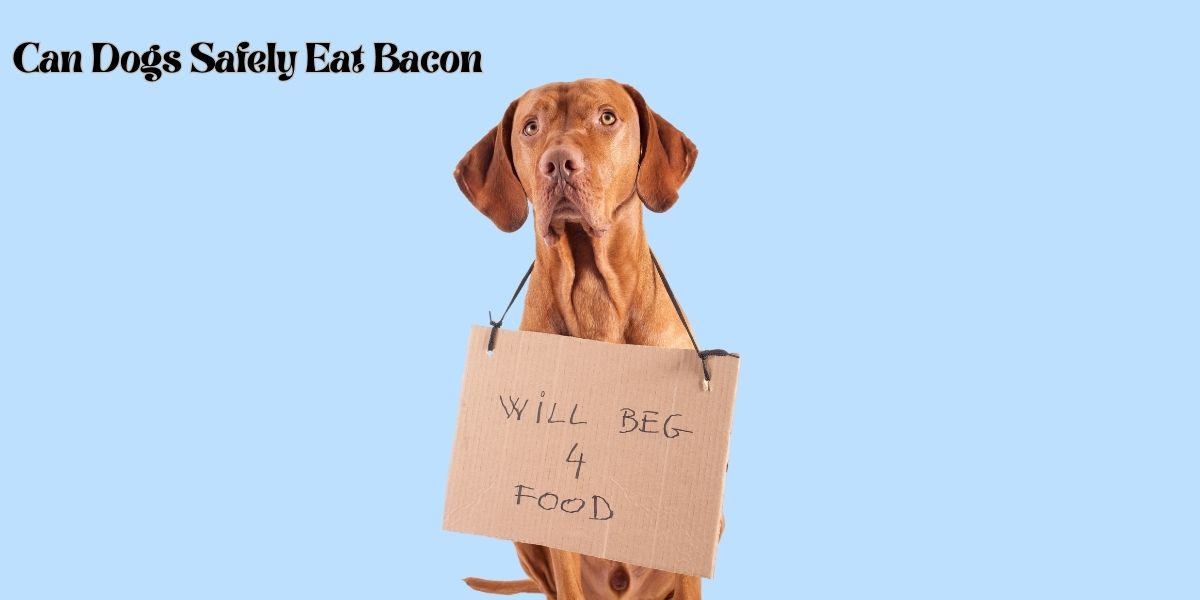Can Dogs Safely Eat Bacon?

If you’ve ever wondered whether dogs can safely eat bacon, you’re not alone. Bacon is undeniably delicious and tempting, but is it safe for our furry friends? In this article, we’ll explore the potential risks and benefits of feeding bacon to dogs. While bacon may be a beloved treat for humans, it’s important to consider the impact it can have on our canine companions’ health. Let’s find out if bacon can be a part of your dog’s diet without any harm.
Can Dogs Eat Bacon?
When it comes to sharing delicious human food with our canine companions, it’s essential to be aware of the potential risks involved. One popular food that many dog owners wonder about is bacon. While it may be tempting to share a savory strip of bacon with your furry friend, it’s important to understand the potential dangers and make an informed decision for your pet’s well-being.
Understanding the Risks of Bacon Consumption
Bacon as a High-Fat Food
One of the main concerns with feeding bacon to dogs is its high-fat content. While dogs require some fat in their diet, excessive consumption of high-fat foods like bacon can lead to a range of health issues. These can include pancreatitis, digestive upset, and obesity. Therefore, it’s crucial to consider the fat content of bacon before offering it to your pup.
The Impact of Sodium in Bacon
Another significant factor to consider is the sodium content in bacon. Sodium, also known as salt, is commonly used in the processing of bacon to enhance flavor and preserve the meat. However, excessive sodium intake can be harmful to dogs. It can lead to issues such as increased blood pressure, heart problems, and even sodium toxicity. Therefore, it’s essential to carefully monitor your dog’s sodium intake, especially if you plan to share bacon with them.
Preservatives and Additives in Bacon
Along with high sodium content, bacon often contains various preservatives and additives. These additives can include nitrates and nitrites, which are used to prolong the shelf life of the meat and enhance its color. While these additives may be safe for human consumption in moderation, they can be harmful to dogs if ingested in large quantities. It’s crucial to read the ingredient labels carefully and opt for bacon with minimal additives if you choose to share it with your furry friend.

The Dangers of High Sodium Content
Health Risks Associated with Sodium
Sodium plays a vital role in the body’s functioning, but excessive intake can pose serious health risks for dogs. One of the primary concerns is the impact on blood pressure and heart health. High levels of sodium can lead to increased blood pressure, stressing the cardiovascular system. Over time, this can contribute to the development of heart disease and other cardiovascular issues in dogs.
Impact on Blood Pressure and Heart Health
Dogs with pre-existing heart conditions or older dogs may be particularly susceptible to the negative effects of high sodium intake. It’s crucial to consult with your veterinarian if your dog has any underlying health conditions before offering them foods like bacon that are high in sodium.
Sodium Toxicity and its Effects on Dogs
In rare cases, excessive sodium consumption can lead to sodium toxicity in dogs. Symptoms of sodium toxicity can include increased thirst, excessive urination, vomiting, diarrhea, lethargy, and even seizures. Sodium toxicity can be life-threatening and requires immediate veterinary attention. Therefore, it’s crucial to be mindful of your dog’s overall sodium intake and avoid feeding them foods like bacon in large quantities.
The Negative Effects of Excessive Fat
Risk of Pancreatitis
Pancreatitis is a severe condition characterized by inflammation of the pancreas. It can be incredibly painful and life-threatening for dogs. Excessive fat consumption, such as indulging in bacon, is one of the primary causes of pancreatitis in dogs. The pancreas becomes overwhelmed by the high-fat content and releases digestive enzymes prematurely, leading to inflammation.
Digestive Upset and Diarrhea
In addition to the risk of pancreatitis, excessive fat consumption can cause digestive upset in dogs. Many dogs are not used to consuming such a high-fat food, and their digestive systems may struggle to process it efficiently. This can result in symptoms such as diarrhea, vomiting, and discomfort.
Weight Gain and Obesity
Just like in humans, a diet high in fat can contribute to weight gain and obesity in dogs. Obesity in dogs can lead to a variety of health issues, including joint problems, diabetes, heart disease, and reduced quality of life. It’s important to remember that even small amounts of bacon can quickly add up in terms of calories and fat content, so it’s crucial to exercise moderation and consider the overall impact on your dog’s weight and health.

Potential Allergic Reactions
Signs of Allergic Reactions in Dogs
While bacon allergy is relatively rare in dogs, it’s essential to be aware of the signs of allergic reactions. These can include itching, redness, hives, swelling, gastrointestinal upset, difficulty breathing, and in severe cases, anaphylaxis. If you notice any of these symptoms after your dog consumes bacon or any other food, it’s important to seek veterinary attention immediately.
Common Food Allergens in Bacon
Bacon contains various potential allergens, including pork, preservatives, and additives. Some dogs may have underlying allergies or sensitivities to these ingredients, making bacon an unsuitable snack for them. If you suspect that your dog may have food allergies, it’s best to consult with your veterinarian to determine specific allergens and develop an appropriate dietary plan.
Pancreatitis as a Serious Concern
Understanding Pancreatitis
Pancreatitis is a condition that causes inflammation of the pancreas, an organ responsible for producing digestive enzymes and regulating blood sugar levels. When a dog consumes high-fat foods like bacon, the pancreas can become overwhelmed and inflamed. This inflammation can be painful and lead to a range of other health complications.
Bacon’s Contribution to Pancreatitis
The high-fat content of bacon can significantly contribute to the development of pancreatitis in dogs. When a dog consumes excessive amounts of fat, the pancreas must work harder to process and release digestive enzymes. Over time, this can result in the inflammation and subsequent damage associated with pancreatitis.
Treating Pancreatitis in Dogs
Pancreatitis in dogs requires prompt veterinary attention and treatment. Treatment often involves hospitalization, fluid therapy, pain management, and dietary adjustments. In severe cases, surgery may be required. Preventing pancreatitis by avoiding high-fat foods like bacon is crucial for your dog’s well-being and long-term health.

The Link Between Bacon and Obesity
Bacon as a Caloric and Fatty Food
Bacon is known for being a rich and indulgent food. It’s high in both calories and fat, making it a potential contributor to obesity in dogs. Although a small piece of bacon may not seem like a significant concern, the cumulative effect of excess calories and fat can contribute to weight gain over time.
The Role of Obesity in Various Health Issues
Obesity in dogs can have a substantial impact on their overall health and well-being. It can increase the risk of developing a range of conditions such as diabetes, joint problems, heart disease, and respiratory issues. Additionally, obesity can reduce a dog’s lifespan and overall quality of life. Therefore, it’s essential to consider the potential long-term effects of feeding bacon and other high-fat foods to your dog.
Preventing and Managing Canine Obesity
Preventing and managing obesity in dogs requires a holistic approach that includes a balanced diet, regular exercise, and portion control. While an occasional small piece of bacon may not have a significant impact, it’s crucial to be mindful of your dog’s overall calorie and fat intake. Consulting with your veterinarian to establish a healthy diet and exercise plan for your dog is the best way to ensure their weight remains within a healthy range.
Cooking Methods that Affect Safety
Avoiding Seasonings, Spices, and Flavorings
Bacon is often prepared with various seasonings, spices, and flavorings that may be harmful to dogs. Ingredients like onion and garlic powder, for example, are toxic to dogs and should be avoided at all costs. Additionally, many flavorings used in processed bacon products can be artificial and potentially harmful. It’s best to offer your dog plain, unseasoned bacon if you choose to share it.
Preventing Undercooked or Overcooked Bacon
Properly cooking bacon is crucial to ensure its safety for both humans and dogs. Undercooked bacon can contain harmful bacteria like salmonella or parasites that can cause serious illness in dogs. On the other hand, overcooked bacon can be too dry and difficult for dogs to chew and digest. Aim for a balance – cook the bacon until it’s crispy but not burnt.
The Risk of Bacon Grease
Bacon grease can be a potential hazard for dogs. It is high in fat and can cause digestive upset, pancreatitis, and even potential obstruction if consumed in large quantities. It’s crucial to prevent dogs from accessing bacon grease, whether by keeping them away from the cooking process or securely disposing of the grease after cooking.
The Importance of Moderation
Portion Control for Dogs
When it comes to sharing bacon or any other indulgent treat with your dog, the key is moderation. While bacon may be a tasty morsel, it should not make up a significant portion of your dog’s diet. Keeping the size of bacon treats small and infrequent helps ensure that your dog’s overall diet remains balanced and healthy.
Frequency of Bacon Treats
Instead of offering bacon on a daily basis, it’s best to consider it as an occasional treat. Reserve bacon for special occasions or as a reward during training sessions. By incorporating it into your dog’s diet sparingly, you can minimize the potential risks associated with bacon consumption.
Balanced Nutrition and Variety
While bacon may be tempting, it’s important to remember that dogs require a balanced and varied diet to thrive. Instead of relying on bacon as a regular treat, explore other healthy alternatives that can provide both nutrition and enjoyment for your dog. There are numerous dog-friendly treats available in the market, or you can even prepare homemade treats using dog-friendly ingredients.
Alternatives to Bacon for Dogs
If you’re looking for safe and healthier alternatives to bacon, there are several options available. Lean meats like skinless chicken or turkey can be prepared and cooked without seasonings to provide a protein-rich treat. Additionally, fruits and vegetables like apple slices, carrot sticks, or blueberries can be excellent low-calorie options for dogs. It’s always a good idea to consult with your veterinarian before introducing any new foods into your dog’s diet.
Consulting with a Veterinarian
Importance of Veterinary Guidance
When it comes to your dog’s diet, it’s crucial to consult with your veterinarian. Every dog is unique, with individual dietary needs and potential health concerns. They can provide tailored advice based on your dog’s specific requirements, ensuring that their diet remains balanced and appropriate.
Individual Factors and Dog’s Health
Your veterinarian will consider various factors, such as your dog’s age, breed, weight, activity level, and any underlying health conditions, when providing dietary recommendations. This personalized approach ensures that your dog’s nutritional needs are met while minimizing the risk of potential health issues associated with certain foods.
Creating a Tailored Diet Plan
If you’re unsure about whether or not to include bacon in your dog’s diet, it’s best to consult with your veterinarian. They can help you create a customized diet plan for your furry friend, taking into account their overall health, dietary preferences, and any specific concerns you may have. With their guidance, you can make informed decisions about what foods to offer your dog, ensuring their well-being and happiness.